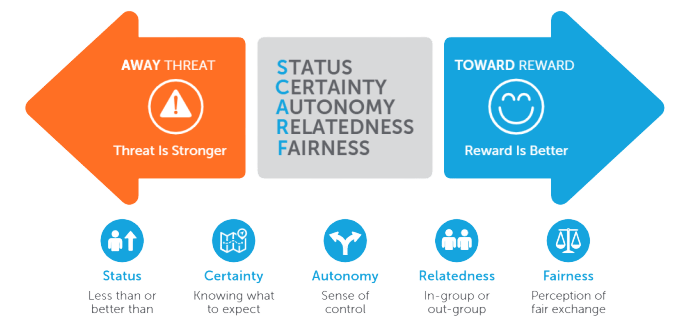- What is it?
- How the brain works?
- How can you use it in your personal and professional life?

NeuroLeadership Institute Education
What is it? & How the brain works?
SCARF is a cognitive model (Rock, 2008) for quickly and easily recalling the potential impact of your actions on others (and other’s actions on you) that can enable possibilities of different choices.
This model can be used in any profession- business leaders, educators, or employees, across any industry… ANYONE looking to INFLUENCE others.
Framework: Points to Keep in Mind
- It is a positive approach to evaluating a situation and looking at potential options.
- The brain is geared towards processing emotional threats and rewards the same way as we experience physical threats and rewards.
- We want more of a good thing: Our perception and experiences of reality can be colored by a “toward” response – seeing opportunities, options, and feeling positive. This creates a positive environment to make decisions, collaborate, solve problems, and focus on feel-good triggers in our brain. On the other side: the “away” response, we experience flight, feel scared, anxious, or nervousness.
Domains: What Makes-Up SCARF
Here is the meaning and example of each domain:
- Status– Less than or better than. “We desire status because it signifies that others value us- that we have a place of importance in the group and therefore are connected to the group” (Liebermann, 2009).
- Certainty– Ability to predict outcomes. “The brain likes to know what is going on by recognizing patterns in the world. It likes to think ahead and picture the future, mapping out how things will be, not just for the moment, but also for the longer term.” (Rock, 2009).
- Autonomy– Sense of control. “A perception of reduced autonomy because of being micromanaged – can generate a threat response. Presenting people with options, or allowing them to organize their own work and set their own hours, provokes much less stress response” (Rock, 2009).
- Relatedness– In-group or out group. “Social connections are essentially the original Internet, connecting different pockets of intelligence to make each pocket more than it would otherwise be by itself.” (Lieberman, 2009).
- Fairness– Perception of fair exchange. “The extent to which employees perceive decisions to be fair in their place of work can account for 20% of the difference in their productivity” (Liberman, 2009).
We like to feel like we have been treated in a fair manner. Fairness is equal access to resources. It is the just and non-biased exchange between people. When we feel that we have been treated unfairly, we experience an array of emotions such as disappointment, anger, and frustration. For example, if you feel you have been treated fairly in a performance review, there is a feeling of excitement and happiness in receiving that raise or bonus.
By understanding what SCARF is and how your brain works, you begin to peel the onion on how to evaluate situations and adjust. Stay tuned for part 2 on how to apply it!
